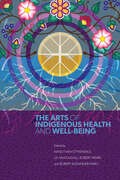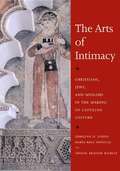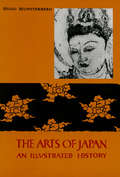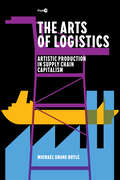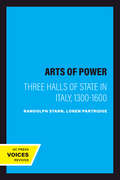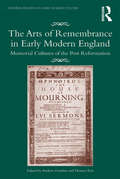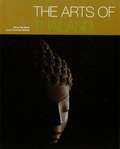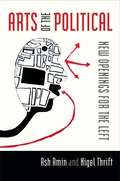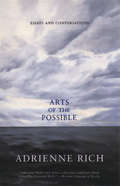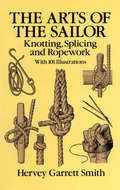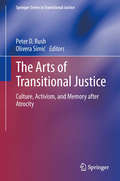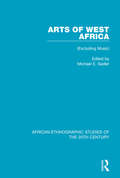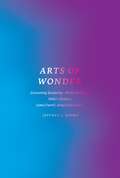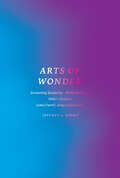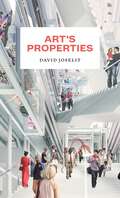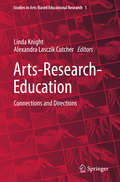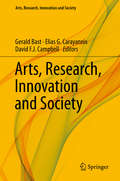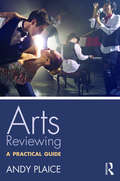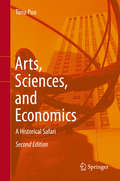- Table View
- List View
The Arts of Indigenous Health and Well-Being
by Edited by Nancy Van Styvendale;J.D. McDougall;Robert Henry;and Robert Alexander InnesDrawing attention to the ways in which creative practices are essential to the health, well-being, and healing of Indigenous peoples, The Arts of Indigenous Health and Well-Being addresses the effects of artistic endeavour on the “good life”, or mino-pimatisiwin in Cree, which can be described as the balanced interconnection of physical, emotional, spiritual, and mental well-being. In this interdisciplinary collection, Indigenous knowledges inform an approach to health as a wider set of relations that are central to well-being, wherein artistic expression furthers cultural continuity and resilience, community connection, and kinship to push back against forces of fracture and disruption imposed by colonialism. The need for healing—not only individuals but health systems and practices—is clear, especially as the trauma of colonialism is continually revealed and perpetuated within health systems. The field of Indigenous health has recently begun to recognize the fundamental connection between creative expression and well-being. This book brings together scholarship by humanities scholars, social scientists, artists, and those holding experiential knowledge from across Turtle Island to add urgently needed perspectives to this conversation. Contributors embrace a diverse range of research methods, including community-engaged scholarship with Indigenous youth, artists, Elders, and language keepers. The Arts of Indigenous Health and Well-Being demonstrates the healing possibilities of Indigenous works of art, literature, film, and music from a diversity of Indigenous peoples and arts traditions. This book will resonate with health practitioners, community members, and any who recognize the power of art as a window, an entryway to access a healthy and good life.
The Arts of Intimacy: Christians, Jews, and Muslims in the Making of Castilian Culture
by Jerrilynn D. Dodds Abigail Krasner Balbale Maria Rosa MenocalNamed a Book of the Year by the Times Literary Supplement, this lavishly illustrated work explores the vibrant interaction among different and sometimes opposing cultures, and how their contacts with one another transformed them all. It chronicles the tumultuous history of Castile in the wake of the Christian capture of the Islamic city of Tulaytula, now Toledo, in the eleventh century and traces the development of Castilian culture as it was forged in the new intimacy of Christians with the Muslims and Jews they had overcome. The authors paint a portrait of the culture through its arts, architecture, poetry and prose, uniquely combining literary and visual arts. Concentrating on the eleventh and twelfth centuries, the book reveals the extent to which Castilian identity is deeply rooted in the experience of confrontation, interaction, and at times union with Hebrew and Arabic cultures during the first centuries of its creation. Abundantly illustrated, the volume serves as a splendid souvenir of southern Spain; beautifully written, it illuminates a culture deeply enriched by others.
Arts of Japan
by Hugo MunsterbergArts of Japan was originally published by Tuttle Publishing in print form in 1957.<P><P> This book," in the words of the author, "represents an attempt to fill a long-felt need for an account of the history of Japanese art which would deal with the crafts as well as with the so-called fine arts and carry the story of Japanese art up to the present day instead of ending with the death of Hiroshige." The reader will quickly perceive how well this aim has been achieved. Here, in a stimulating and informative text and 121 well-selected plates -12 in full colour-is a dynamic treatment of the various influences that have shaped the course of Japanese art history in the fields of painting, sculpture, architecture, and handicrafts. Discussed with challenging insight are the impact of the various Indian and Chinese schools, the pervasive influenceof Zen philosophy, and the many other artistic developments, giving the reader awell-rounded picture of the great significance and contribution of Japanese art. Special features of the book are sections on handicrafts and a chapter on prehistoric art. The book comes at a time when there is an awakened interest in Oriental art throughout the world. At the same time new methods of art research have been so expanded and refined that many interpretations of earlier writers have been made obsolete. Because of linguistic barriers, political upheavals, and the limited number of specialists, misconceptions have been especially numerous in the field of Oriental art. THE ARTS OF JAPAN admirably corrects these misinterpretations, consolidates the results of the most recent scholarship, and in one compact volume presents an up-to-date, authoritative survey of Japanese an throughout its long history and in all its colorful diversity.
Arts of Living on a Damaged Planet: Ghosts and Monsters of the Anthropocene
by Anna Lowenhaupt Tsing Elaine Gan Heather Anne Swanson Nils BubandtLiving on a damaged planet challenges who we are and where we live. This timely anthology calls on twenty eminent humanists and scientists to revitalize curiosity, observation, and transdisciplinary conversation about life on earth.As human-induced environmental change threatens multispecies livability, Arts of Living on a Damaged Planet puts forward a bold proposal: entangled histories, situated narratives, and thick descriptions offer urgent &“arts of living.&” Included are essays by scholars in anthropology, ecology, science studies, art, literature, and bioinformatics who posit critical and creative tools for collaborative survival in a more-than-human Anthropocene. The essays are organized around two key figures that also serve as the publication&’s two openings: Ghosts, or landscapes haunted by the violences of modernity; and Monsters, or interspecies and intraspecies sociality. Ghosts and Monsters are tentacular, windy, and arboreal arts that invite readers to encounter ants, lichen, rocks, electrons, flying foxes, salmon, chestnut trees, mud volcanoes, border zones, graves, radioactive waste—in short, the wonders and terrors of an unintended epoch.Contributors: Karen Barad, U of California, Santa Cruz; Kate Brown, U of Maryland, Baltimore; Carla Freccero, U of California, Santa Cruz; Peter Funch, Aarhus U; Scott F. Gilbert, Swarthmore College; Deborah M. Gordon, Stanford U; Donna J. Haraway, U of California, Santa Cruz; Andreas Hejnol, U of Bergen, Norway; Ursula K. Le Guin; Marianne Elisabeth Lien, U of Oslo; Andrew Mathews, U of California, Santa Cruz; Margaret McFall-Ngai, U of Hawaii, Manoa; Ingrid M. Parker, U of California, Santa Cruz; Mary Louise Pratt, NYU; Anne Pringle, U of Wisconsin, Madison; Deborah Bird Rose, U of New South Wales, Sydney; Dorion Sagan; Lesley Stern, U of California, San Diego; Jens-Christian Svenning, Aarhus U.
The Arts of Logistics: Artistic Production in Supply Chain Capitalism (Post*45)
by Michael Shane BoyleWe live in a world where nothing is untouched by supply chains—art included. In this major contribution to the study of contemporary culture and supply chains, Michael Shane Boyle has assembled a global inventory of aesthetics since the 1950s that reveals logistics to be a pervasive means of artistic production. The Arts of Logistics provides a new map of supply chain capitalism, scrutinizing how artists retool technologies designed for circulating commodities. What emerges is a magisterial account of the logistics revolution that foregrounds the role played by art in the long downturn of global capitalism. With chapters on art produced from technologies including ships, barrels, containers, and drones, Boyle narrates the long history of art's connection to logistics, beginning in the transatlantic slave trade and continuing today in Silicon Valley's dreams of automation. The global reach of the artists considered reflects the geographies of supply chain capitalism itself. In taking stock of how performance, sculpture, and popular culture are entangled in trade and racialized labor regimes, Boyle profiles influential work by artists such as Christo and Allan Kaprow alongside that of contemporary figures including Cai Guo-Qiang and Selina Thompson. This incisive study demonstrates that art and logistics are linked by the infrastructures and violence that keep supply chains moving.
Arts of Perception: The Epistemological Mentality of the Spanish Baroque, 1580-1720
by Jeremy RobbinsArts of Perception offers a new account of a key period in Spanish history and culture and a fundamental reassessment of its major writers and intellectuals, including Gracián, Quevedo, Calderón, Saavedra Fajardo, López de Vega, and Sor Juana. Reading these figures in the context of European thought and the new science, and philosophy, the study considers how they developed various ‘arts of perception’ - complex perceptual strategies designed to overcome and exploit epistemic problems to enable an individual to act effectively in the moral, political, social or religious sphere. The study takes as its subject the distinctive epistemological mentality behind such ‘arts of perception’. This mentality was fostered by the creative interaction of scepticism and Stoicism, and found expression in the key concepts ser/parecer and engaño/desengaño. The work traces the emergence, development, and impact of these concepts on Spanish thought and culture. As well as offering new interpretations of specific major figures, Arts of Perception offers an interpretation of the mentality of an entire culture as it made the fraught transition to intellectual modernity. As such it ranges over numerous discourses and formative contexts and provides a wealth of new material which will be of use to all those seeking to understand and interpret the literature, culture and thought of Golden Age Spain. This book was previously published as a special issue of The Bulletin of Spanish Studies.
Arts of Power: Three Halls of State in Italy, 1300-1600 (The New Historicism: Studies in Cultural Poetics #19)
by Randolph Starn Loren PartridgeThis title is part of UC Press's Voices Revived program, which commemorates University of California Press’s mission to seek out and cultivate the brightest minds and give them voice, reach, and impact. Drawing on a backlist dating to 1893, Voices Revived makes high-quality, peer-reviewed scholarship accessible once again using print-on-demand technology. This title was originally published in 1992.This title is part of UC Press's Voices Revived program, which commemorates University of California Press’s mission to seek out and cultivate the brightest minds and give them voice, reach, and impact. Drawing on a backlist dating to 1893, Voices Revived</DIV
The Arts of Remembrance in Early Modern England: Memorial Cultures of the Post Reformation (Material Readings in Early Modern Culture)
by Andrew Gordon Thomas RistThe early modern period inherited a deeply-ingrained culture of Christian remembrance that proved a platform for creativity in a remarkable variety of forms. From the literature of church ritual to the construction of monuments; from portraiture to the arrangement of domestic interiors; from the development of textual rites to drama of the contemporary stage, the early modern world practiced 'arts of remembrance' at every turn. The turmoils of the Reformation and its aftermath transformed the habits of creating through remembrance. Ritually observed and radically reinvented, remembrance was a focal point of the early modern cultural imagination for an age when beliefs both crossed and divided communities of the faithful. The Arts of Remembrance in Early Modern England maps the new terrain of remembrance in the post-Reformation period, charting its negotiations with the material, the textual and the performative.
The Arts of Thailand
by Luca Invernizzi Tettoni Steve Van BeekFor over a thousand years, Thailand has been a cultural crossroads for the artistic traditions of India, Sri Lanka, Cambodia, and Indonesia, gradually evolving a unique style of artistic expression all its own. Based on exhaustive museum, library, and temple research, The Arts of Thailand covers every major form and period of Thai art and provides a complete overview of one of the world's richest artistic traditions.
The Arts of the Microbial World: Fermentation Science in Twentieth-Century Japan (Synthesis)
by Victoria LeeThe first in-depth study of Japanese fermentation science in the twentieth century.The Arts of the Microbial World explores the significance of fermentation phenomena, both as life processes and as technologies, in Japanese scientific culture. Victoria Lee’s careful study documents how Japanese scientists and skilled workers sought to use the microbe’s natural processes to create new products, from soy-sauce mold starters to MSG, vitamins to statins. In traditional brewing houses as well as in the food, fine chemical, and pharmaceutical industries across Japan, they showcased their ability to deal with the enormous sensitivity and variety of the microbial world. Charting developments in fermentation science from the turn of the twentieth century, when Japan was an industrializing country on the periphery of the world economy, to 1980 when it had emerged as a global technological and economic power, Lee highlights the role of indigenous techniques in modern science as it took shape in Japan. In doing so, she reveals how knowledge of microbes lay at the heart of some of Japan’s most prominent technological breakthroughs in the global economy. At a moment when twenty-first-century developments in the fields of antibiotic resistance, the microbiome, and green chemistry suggest that the traditional eradication-based approach to the microbial world is unsustainable, twentieth-century Japanese microbiology provides a new, broader vantage for understanding and managing microbial interactions with society.
Arts of the Political: New Openings for the Left
by Amin Ash Thrift NigelIn the West, "the Left," understood as a loose conglomeration of interests centered around the goal of a fairer and more equal society, still struggles to make its voice heard and its influence felt, even amid an overwhelming global recession. In Arts of the Political: New Openings for the Left, Ash Amin and Nigel Thrift argue that only by broadening the domain of what is considered political and what can be made into politics will the Left be able to respond forcefully to injustice and inequality. In particular, the Left requires a more imaginative and experimental approach to the politics of creating a better society. The authors propose three political arts that they consider crucial to transforming the Left: boosting invention, leveraging organization, and mobilizing affect. They maintain that successful Left political movements tend to surpass traditional notions of politics and open up political agency to these kinds of considerations. In other words, rather than providing another blueprint for the future, Amin and Thrift concentrate their attention on a more modest examination of the conduct of politics itself and the ways that it can be made more effective.
Arts of the Possible: Essays and Conversations
by Adrienne Rich"Adrienne Rich's new prose collection could have been titled The Essential Rich."--Women's Review of Books These essays trace a distinguished writer's engagement with her time, her arguments with herself and others. "I am a poet who knows the social power of poetry, a United States citizen who knows herself irrevocably tangled in her society's hopes, arrogance, and despair," Adrienne Rich writes. The essays in Arts of the Possible search for possibilities beyond a compromised, degraded system, seeking to imagine something else. They call on the fluidity of the imagination, from poetic vision to social justice, from the badlands of political demoralization to an art that might wound, that may open scars when engaged in its work, but will finally suture and not tear apart. This volume collects Rich's essays from the last decade of the twentieth century, including four earlier essays, as well as several conversations that go further than the usual interview. Also included is her essay explaining her reasons for declining the National Medal for the Arts. "The work is inspired and inspiring."--Alicia Ostriker "[S]o clear and clean and thorough. I learn from her again and again."--Grace Paley
The Arts of the Sailor: Knotting, Splicing and Ropework
by Hervey Garrett SmithOver 150 years ago, the skills needed to operate a merchant sailing vessel were many and varied. While not nearly as much in demand today as they were in the days of the Yankee clippers, these skills nevertheless remain important and necessary to today's yachtsmen and owners of smaller pleasure boats.In this excellent handbook on basic shipboard skills, marine expert Hervey Garrett Smith offers boating and yachting enthusiasts a complete course in rigging, working, and maintaining a ship. More than 100 illustrations help the reader grasp the fundamentals and fine points of handling a ship while the author describes in detail a sailor's tools, basic knots, and useful hitches as well as the arts of splicing, handsewing, and canvas work.Other topics equally important to safe, economical, and efficient boat maintenance and management include belaying, coiling, and stowing; towing procedures; how to make a chafing gear; and much more. Easy-to-follow instructions for fashioning decorative knots, ornamental coverings, and nettings, and even how to make a proper bucket round out this engaging and informative guide.Packed with useful "hands-on" information conveyed in a chatty, humorous style, The Arts of the Sailor is the perfect book to keep aboard ship for study and for ready reference when the need arises. It also makes delightful reading for armchair sailors and the legions of landlubbers with an interest in the sea.
The Arts of Transitional Justice
by Peter D. Rush Olivera SimićThe Art of Transitional Justice examines the relationship between transitional justice and the practices of art associatedwith it. Art, which includes theater, literature, photography, and film, hasbeen integral to the understanding of the issues faced in situations oftransitional justice as well as other issues arising out ofconflict and mass atrocity. The chapters in this volume take up this understandingand its demands of transitional justice in situations in several countries:Afghanistan, Serbia, Srebenica, Rwanda, Northern Ireland, Cambodia, as well asthe experiences of resulting diasporic communities. In doing so, it brings tobear the insights from scholars, civil society groups, and art practitioners,as well as interdisciplinary collaborations.
Arts of West Africa: (Excluding Music) (Black Heritage Library Collection)
by Michael E. SadlerOriginally published in 1935, the aim of this book was to introduce the European to the art of West Africa. Many of the examples (extensively illustrated with black and white photos are from the regions between Senegal and Angola, primarily from Gambia, Sierra Leone, the Gold Coast, Nigeria and the Cameroons. Although the art and sculpture of West Africa is coherent, there are tribal and territorial characteristics which are discussed as is the significance of masks in ritual ceremony.
Arts of Wonder: Enchanting Secularity--Walter De Maria, Diller + Scofidio, James Turrell, Andy Goldsworthy
by Jeffrey L. Kosky"The fate of our times is characterized by rationalization and intellectualization and, above all, by 'the disenchantment of the world. '" Max Weber's statement remains a dominant interpretation of the modern condition: the increasing capabilities of knowledge and science have banished mysteries, leaving a world that can be mastered technically and intellectually. And though this idea seems empowering, many people have become disenchanted with modern disenchantment. Using intimate encounters with works of art to explore disenchantment and the possibilities of re-enchantment, Arts of Wonder addresses questions about the nature of humanity, the world, and God in the wake of Weber's diagnosis of modernity. Jeffrey L. Kosky focuses on a handful of artists--Walter De Maria, Diller + Scofidio, James Turrell, and Andy Goldworthy--to show how they introduce spaces hospitable to mystery and wonder, redemption and revelation, and transcendence and creation. What might be thought of as religious longings, he argues, are crucial aspects of enchanting secularity when developed through encounters with these works of art. Developing a model of religion that might be significant to secular culture, Kosky shows how this model can be employed to deepen interpretation of the art we usually view as representing secular modernity. A thoughtful dialogue between philosophy and art, Arts of Wonder will catch the eye of readers of art and religion, philosophy of religion, and art criticism.
Arts of Wonder: Enchanting Secularity—Walter De Maria, Diller + Scofidio, James Turrell, Andy Goldsworthy (Religion And Postmodernism Ser.)
by Jeffrey L. Kosky“The fate of our times is characterized by rationalization and intellectualization and, above all, by ‘the disenchantment of the world.’” Max Weber’s statement remains a dominant interpretation of the modern condition: the increasing capabilities of knowledge and science have banished mysteries, leaving a world that can be mastered technically and intellectually. And though this idea seems empowering, many people have become disenchanted with modern disenchantment. Using intimate encounters with works of art to explore disenchantment and the possibilities of re-enchantment, Arts of Wonder addresses questions about the nature of humanity, the world, and God in the wake of Weber’s diagnosis of modernity. Jeffrey L. Kosky focuses on a handful of artists—Walter De Maria, Diller + Scofidio, James Turrell, and Andy Goldsworthy—to show how they introduce spaces hospitable to mystery and wonder, redemption and revelation, and transcendence and creation. What might be thought of as religious longings, he argues, are crucial aspects of enchanting secularity when developed through encounters with these works of art. Developing a model of religion that might be significant to secular culture, Kosky shows how this model can be employed to deepen interpretation of the art we usually view as representing secular modernity. A thoughtful dialogue between philosophy and art, Arts of Wonder will catch the eye of readers of art and religion, philosophy of religion, and art criticism.
Arts Programming for the Anthropocene: Art in Community and Environment (Routledge Environmental Humanities)
by Bill Gilbert Anicca CoxArts Programming for the Anthropocene argues for a role for the arts as an engaged, professional practice in contemporary culture, charting the evolution of arts over the previous half century from a primarily solitary practice involved with its own internal dialogue to one actively seeking a larger discourse. The chapters investigate the origin and evolution of five academic field programs on three continents, mapping developments in field pedagogy in the arts over the past twenty years. Drawing upon the collective experience of artists and academicians in the United States, Australia, and Greece operating in a wide range of social and environmental contexts, it makes the case for the necessity of an update to ensure the real world relevance and applicability of tertiary arts education. Based on thirty years of experimentation in arts pedagogy, including the creation of the Land Arts of the American West (LAAW) program and Art and Ecology discipline at the University of New Mexico, this book is written for arts practitioners, aspiring artists, art educators, and those interested in how the arts can contribute to strengthening cultural resiliency in the face of rapid environmental change.
Art’s Properties
by David JoselitA revisionist reading of modern art that examines how artworks are captured as property to legitimize powerIn this provocative new account, David Joselit shows how art from the nineteenth to the twenty-first centuries began to function as a commodity, while the qualities of the artist, nation, or period themselves became valuable properties. Joselit explores repatriation, explaining that this is not just a contemporary conflict between the Global South and Euro-American museums, noting that the Louvre, the first modern museum, was built on looted works and faced demands for restitution and repatriation early in its history. Joselit argues that the property values of white supremacy underlie the ideology of possessive individualism animating modern art, and he considers issues of identity and proprietary authorship.Joselit redefines art’s politics, arguing that these pertain not to an artwork’s content or form but to the way it is “captured,” made to represent powerful interests—whether a nation, a government, or a celebrity artist collected by oligarchs. Artworks themselves are not political but occupy at once the here and now and an “elsewhere”—an alterity—that can’t ever be fully appropriated. The history of modern art, Joselit asserts, is the history of transforming this alterity into private property.Narrating scenes from the emergence and capture of modern art—touching on a range of topics that include the Byzantine church, French copyright law, the 1900 Paris Exposition, W.E.B. Du Bois, the conceptual artist Adrian Piper, and the controversy over Dana Schutz’s painting Open Casket—Joselit argues that the meaning of art is its infinite capacity to generate experience over time.
Arts Property and Hotel
by Arthur I SegelJulio Martinez finds himself as one of the owners of the Arts Hotel Project in Barcelona, Spain. The 455-room hotel is managed by the Ritz Carlton and is in a 44-story tower along Barcelona's beachfront. Julio needs to figure out a strategy to maximize his investment, including a negotiation of the Ritz's operating agreement. Includes color exhibits.
Arts-Research-Education: Connections and Directions (Studies in Arts-Based Educational Research #1)
by Linda Knight Alexandra Lasczik CutcherDrawing from an international authorship and having global appeal, this book scrutinizes, suggests and aggravates the relationships, boundaries and connections between arts, research and education in various contexts. Building upon existing publications in the field of arts-based educational research, it deliberately connects and disconnects the terms in order to expose and broaden the scope of this field thereby encouraging fresh perspectives. This book portrays both contemporary theoretical prospects as well as contemporary examples of practice. It also presents work of emerging scholars, thereby 'growing the field'. The book includes academic text-based chapters, as well as poetry, narrative fiction, visual essays, and combinations of text-image-sound/video that demonstrate performance of music, theatre, exhibition and dance. This book provides and provokes critical dialogue about the forms, representations, dissemination and intersections of the arts, research and education. This is a focused collection and resource for scholars and students with an international authorship, perspective and audience.
Arts, Research, Innovation and Society (Arts, Research, Innovation and Society)
by Elias G. Carayannis David F. J. Campbell Gerald BastThis book explores - at the macro, meso and micro levels and in terms of qualitative as well as quantitative studies - theories, policies and practices about the contributions of artistic research and innovations towards defining new forms of knowledge, knowledge production, as well as knowledge diffusion, absorption and use. Artistic research, artistic innovations and arts-based innovations have been major transformers, as well as disruptors, of the ways in which societies, economies, and political systems perform. Ramifications here refer to the epistemic socio-economic, socio-political and socio-technical base and aesthetic considerations on the one hand, as well as to strategies, policies, and practices on the other, including sustainable enterprise excellence, considerations in the context of knowledge economies, societies and democracies. Creativity in general, and the arts in particular, are increasingly recognized as drivers of cultural, economic, political, social, and scientific innovation and development. This book examines how one could derive and develop insights in these areas from the four vantage points of Arts, Research, Innovation and Society. Among the principal questions that are examined include: - Could and should artists be researchers? - How are the systems of the Arts and Sciences connected and/or disconnected? - What is the impact of the arts in societal development? - How are the Arts interrelated with the mechanisms of generating social, scientific and economic innovation? As the inaugural book in the Arts, Research, Innovation and Society series, this book uses a thematically wide spectrum that serves as a general frame of reference for the entire series of books to come.
Arts Reviewing: A Practical Guide
by Andy PlaiceArts Reviewing: A Practical Guide is an accessible introduction to the world of arts criticism. Drawing on professional expertise and a range of cultural reviews from music, film, theatre, visual arts, television and books, Andy Plaice discusses different approaches to arts criticism, with tips on crafting great reviews. Chapters explore: • a brief history of arts criticism; • researching and preparing for an assignment; • legal and ethical boundaries when reviewing; • finding your own writing style; • starting and sustaining a career in arts criticism in the digital age. The book is underpinned by over 20 interviews with leading practitioners from across Britain, America and Australia. They offer fascinating insights into the life of a critic, including their best and worst career moments and the debates impacting the field of arts criticism. Interviewees include Neil McCormick, rock critic at the Daily Telegraph, the Guardian theatre critic Lyn Gardner and television critic Mark Lawson (BBC/ the Guardian). New approaches to reviewing techniques and writing style are combined with real-world advice from leading professionals in the field, making this book an ideal resource for students and graduates of journalism, cultural studies and media studies.
Arts, Sciences, and Economics: A Historical Safari
by Tönu PuuThis book deals with the economic aspects of changing attitudes in arts and sciences. The effects of the public good character of culture, along with the very long production period and lifetime for its products, are emphasized, since both contribute to the failure of normal market solutions. Embodiment of ideas and the consequences of modern reproduction technology for protection of property rights are closely examined. The evolution within arts and sciences, which often seems to return to previously scrapped ideals, is illustrated by detailed case studies, in which the importance of changing tastes, rather than progress proper, is emphasized. The author attempts an understanding for this using Darwinian evolution in combination with modern mathematical complexity theory, expressed in terms accessible to the general reader. The second edition is extended and updated especially as regards the illustration material.
